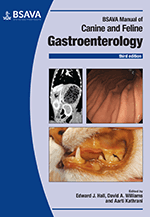
Full text loading...

There are various imaging modalities available for assessing the gastrointestinal (GI) tract, liver and pancreas. Ultrasonography is generally the imaging modality of choice. However, plain radiography can be very helpful in assessing the oesophagus and detecting specific GI diseases and computed tomography has proven very useful for assessing specific disorders of the liver and pancreas.
Imaging of the gastrointestinal tract, liver and pancreas, Page 1 of 1
< Previous page | Next page > /docserver/preview/fulltext/10.22233/9781910443361-3e/BSAVA_Manual_Gastroenterology_3_9781910443361-3e.3.12-24-1.gif

Full text loading...






























